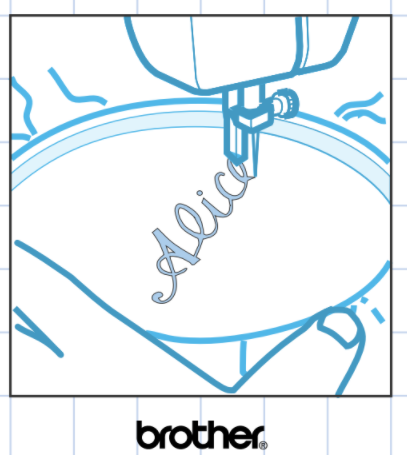IMPORTANT SAFETY INSTRUCTIONS
When using the sewing machine, basic safety precautions should always be followed, including the following:
“Read all instructions before using.”
DANGER –
To reduce the risk of electric shock:
- 1. The sewing machine should never be left unattended when plugged in. Always unplug this sewing machine from the electrical outlet immediately after using and before cleaning .
- 2. Always unplug before changing the light bulb. Replace bulb with same type rated a 15 watt.
WARNING –
To reduce the risk of burns, fire, electric shock, or injury to persons:
- Do not allow this machine to be used as a toy. Close attention is necessary when the sewing machine is used by or near children.
- Use this sewing machine only for its intended use as described in this manual. Use only accessories recommended by the manufacturer as contained in this manual.
- Never operate this sewing machine if it has a damaged cord or plug, if it is not working properly, if it has been dropped or damaged, or dropped into water. Return the sewing machine to the nearest authorized dealer or service center for examination, repair, electrical or mechanical adjustment.
- Never operate the sewing machine with any of the air openings blocked. Keep the ventilation openings of the sewing machine and foot controller free from the accumulation of lint, dust and loose cloth.
- Never drop or insert any object into any openings.
- Do not use this machine outdoors.
- Do not operate this machine where aerosol (spray) products are being used or where oxygen is being administered.
- To disconnect, turn the main switch to the symbol “O” position which represents off, then remove plug from outlet.
- Do not unplug by pulling on the cord. To unplug, grasp the plug and pull, not the cord.
- Keep fingers away from all moving parts. Special care is required around the sewing machine needle.
- Always use the proper needle plate. The wrong plate can cause the needle to break.
- Do not use a bent needle.
- Do not pull or push the fabric while stitching. It may deflect the needle causing it to break.
- Switch the sewing machine to the off, symbol “O” position when making any adjustments in the needle area, such as threading the needle, changing the needle, threading the bobbin, or changing the presser foot.
- Always unplug the sewing machine from the electrical outlet when removing covers, lubricating, or when making any other user service adjustments mentioned in this instruction manual.
“SAVE THESE INSTRUCTIONS”
“This sewing machine is intended for household use.”
FOR USERS IN THE UK, EIRE, MALTA AND CYPRUS ONLY.
If your sewing machine is fitted with a 3 pin non-rewireable BS plug then please read the following.
IMPORTANT
If the available socket outlet is not suitable for the plug supplied with this equipment, it should be cut off and appropriate three pin plug fitted. With alternative plugs an approved fuse must be fitted in the plug.
NOTE: The plug severed from the main leads must be destroyed as a plug with bared flexible cords is hazardous if engaged in a live socket outlet. In the event of replacing the plug fuse, use a fuse approved by ASTA to BS 1362, i.e. carrying the ASA mark, rating as marked on plug.
Always replace the fuse cover. Never use plugs with the fuse cover removed.
WARNING: DO NOT CONNECT EITHER WIRE TO THE EARTH TERMINAL WHICH IS MARKED WITH THE LETTER ‘E’, BY THE EARTH SYMBOL OR COLORED GREEN OR YELLOW.
The wires in these main leads are colored in accord ance with the following code:
Blue: Neutral
Brown: Live
As the colours of the wiring in the mains lead of this appliance may not correspond with the coloured markings identifying the terminals in your plug, pro ceed as follows:
The wire which is coloured blue must be connected to the terminal which is marked with the letter ‘N’ or coloured black or blue.
The wire which is coloured brown must be connected to the terminal which is marked with the letter ‘L’ or coloured red or brown.
Connecting Plugs and Main Power / Sewing Light Switch
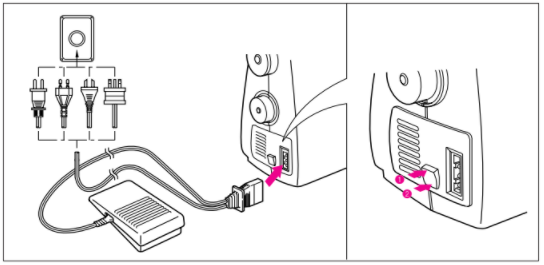
1. Connect the three-prong plug into the machine.
2. Connect the electrical supply plug into a wall outlet.
– When leaving the sewing machine unattended, the main switch of the machine must be switched off or the plug must be removed from the socket outlet.
Turn on or off the switch for the main power and sew light.
- 1 Turn on
- 2 Turn off
– When servicing the sewing machine, or when removing covers or changing lamps, the ma chine or the electrical set must be disconnected from the supply by removing the plug from the socket outlet.
READ ALSO: Amazon Echo Spot User Manual
Principal parts
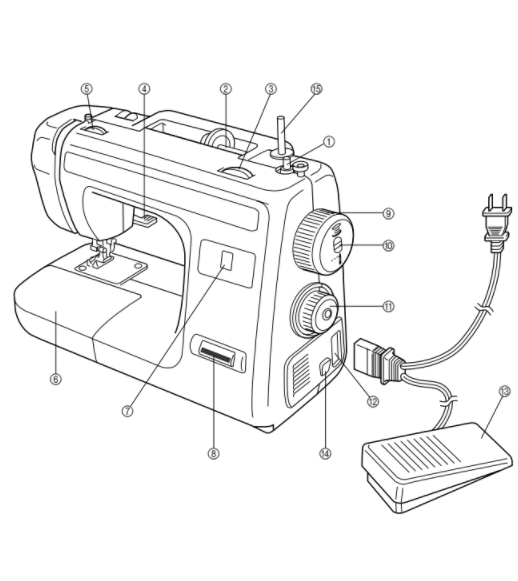
1 BOBBIN WINDING ASSEMBLY
Winds the thread onto the bobbin to be used for the lower thread.
2 SPOOL HOLDER
Holds the sewing thread.
3 STITCH LENGTH DIAL
Controls the length of the stitches.
4 PRESSER FOOT LEVER
Raises and lowers the presser foot.
5 UPPER TENSION CONTROL DIAL Controls the tension of the upper thread. 6 EXTENSION TABLE & ACCESSORIES COM PARTMENT
Converts from the free-arm into a flat bed ma chine.
7 PATTERN INDICATION WINDOW
Shows the stitch to be performed.
8 REVERSE SEWING BUTTON
Push for stitching in the reverse direction.
9 BALANCE WHEEL
Turn toward you (counterclockwise) to raise and lower the needle.
10 CLUTCH RELEASE SWITCH
Switches from bobbin-winding mode to sewing mode.
11 PATTERN SELECTION DIAL
Turn in either direction to select the desired stitch.
12 FOOT CONTROLLER RECEPTACLE Insert the foot controller plug for operation.
13 FOOT CONTROLLER
Used to control sewing speed start and stop.
14 MAIN POWER/SEWING LIGHT SWITCH Turns the main power and sewing light on and off.
15 VERTICAL SPOOL HOLDER
Used to hold a second spool of thread for twin needle sewing.
Accessories

- 1 Buttonhole Foot (1 pc.)
- 2 Zipper Foot (1 pc.)
- 3 Button Sewing Foot (1 pc.)
- 4 Needle Pack (Regular Single Needle No. 14) (3 pcs.)
- 5 Twin Needle (1 pc.)
- 6 Bobbin (3 pcs.)
- 7 Darning Plate (1 pc.)
- 8 Screw Drivers (Large & Small) (2 pcs.)
- 9 Extra Spool Pin (1 pc.)
- 10 Spool Holder (Large & Small) (2 pcs.)
Parts Code for Zigzag Presser Foot: 138135-051
Foot Controller:
- J00360051 (110/120V Area)
- J00016051 (220/240V Area)
- J00492051 (U.K.)
- J00921051 (Australia, New Zealand)
- J01367051 (Canada)
- J00478051 (110/220V Dual Area)
The above accessories are stored in the accessory bag inside the extension table. These accessories have been designed to help complete most sewing tasks.
OPERATING YOUR SEWING MACHINE
Connecting Plugs
1. Connect the three-prong plug into the machine. It is located between the foot controller and the power supply plug on the cord.
2. Connect the power supply plug into a wall outlet.
CAUTION
1. When changing the light bulb or when the sewing machine is not in use, the power sup ply plug must be disconnected from the wall socket to avoid electrical hazards.
2. This appliance has a polarized plug (one blade wider than the other). To reduce the risk of electric shock, this plug is intended to fit in a polarized outlet only one way.
If the plug does not fit fully in the outlet, reverse the plug.
If it still does not fit, contact a qualified electri cian to install the proper outlet.
Do not modify the plug in any way.
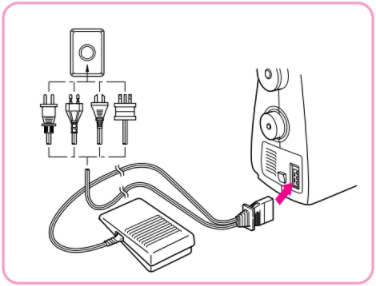
Main Power and Sewing
This switch turns the main power and sewing light on or off
1 Turn on (toward the “I” mark)
2 Turn off (toward the “O” mark)
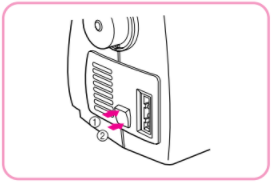
Foot Controller
When the foot controller is depressed lightly, the machine will run at a low speed. When the pressure on the foot controller is increased, the machine’s speed will increase. When pressure on the foot controller is released, the machine will stop. Care should be taken that nothing is placed on the foot controller when the machine is not in use.
1 Foot controller: Model N
Note (For U.S.A. only):
This foot controller can be used for sewing machine models XL3010 and XL3022.

Replacing the Needle
- 1. Remove the power supply plug from the outlet.
- 2. Raise the needle bar to its highest position.
- 3. Lower the presser foot.
- 4. Remove the needle by loosening the needle clamp with a coin.
- 5. Insert a different needle as far as possible up against the needle stopper with its flat side facing the back.
- 6. Tighten the needle clamp.
1. Coin

Checking the Needle
- 1. The sewing needle must always be straight and sharp for smooth sewing.
- 2. To check if the needle is bent, place the flat side of the needle down as shown in the illustration.
- 3. Replace the needle if it is bent or dull.
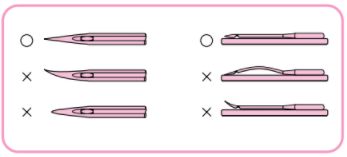
Changing the Presser
It may be necessary to change the presser foot according to your sewing needs.
SNAP-ON TYPE
1. Raise the needle to its highest position by turning balance wheel toward you (counter clockwise) and raise the presser foot lever.
2. Release the foot by raising the lever located at the back of the holder.
3. Place a different presser foot on the needle plate so that the bar on the presser foot is in line with the slot on the shank.
4. Lower the presser foot lever and fix the presser foot onto the shank. If the presser foot is in the correct location, the bar should snap in.

Converting to Free-arm Style
Free-arm sewing is convenient for sewing tubular and hard-to-reach areas on a garment. To change your machine to the free-arm style, simply lift out the extension table.
- 1 Lift up on the extension table.
- 2 Slide the extension table to the left.
1 Extension table
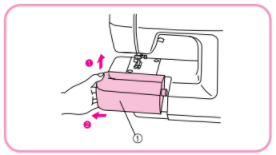
VARIOUS CONTROLS
Pattern Selection Dial
To select a stitch, simply turn the Pattern Selection Dial, located on the right side of the machine. The stitch selection dial may be turned in either direction. All stitches are preset in width, therefore, the stitch length is the only other necessary adjustment. The following table indicates the preset width of each stitch and the recommended range of its stitch length.
1. Pattern selection dial
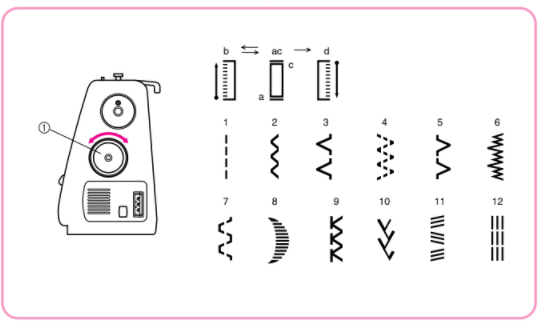
RECOMMENDED LENGTHS FOR STITCHES
| PATTERN | STITCH NAME | PRESET WIDTH [mm(inch)] | RECOMMENDED LENGTH [mm(inch)] | PAGE IN INSTRUCTIONS |
| a-b-c-d | 4-STEP AUTOMATIC BUTTONHOLE | 5 (13/64) | F-1.5 (1/64-1/16) | 31 |
| 1 | STRAIGHT STITCH (Left needle position) | 0 | 1-4 (3/64-5/32) | 22 |
| 2 | STRAIGHT STITCH (Center needle position) | 0 | 1 -4 (3/64-5/32 | 22 |
| 3 | ZIGZAG STITCH | 1.5 (1/16) | F-4 (1/64-5/32) | 25 |
| 4 | ZIGZAG STITCH | 3.5 (9/64) | F-4 (1/64-5/32) | 25 |
| 5 | ZIGZAG STITCH | 5 (13/64) | F-4 (1/64-5/32) | 25 |
| 6 | BLIND HEM STITCH | 3 (1/8) | F-2 (1/64-5/64) | 26 |
| 7 | STRETCH BLIND STITCH | 3 (1/8) | F-1.5 (1/64-1/16) | 26 |
| 8 | SCALLOP STITCH | 5 (13/64) | F-1.5 (1/64-1/16) | 27 |
| 9 | ELASTIC OVERLOCK STITCH | 5 (13/64) | Fixed 2.5 (3/32) | 28 |
| 10 | ELASTIC STITCH | 5 (13/64) | F-2.5 (1/64-3/32) | 29 |
| 11 | TRIPLE ZIGZAG STRETCH STITCH | 5 (13/64) | Fixed 2.5 (3/32) | 30 |
| 12 | TRIPLE STRETCH STITCH | 0 | Fixed 2.5 (3/32) | 32 |
Stitch Length Dial
Depending on your selected stitch, you may need to adjust the stitch length for best results. The numbers marked on the Stitch length dial represent the length of the stitch in millimeters (mm).
THE HIGHER THE NUMBER, THE LONGER THE STITCH.
The “O” setting does not feed the material. This is used for sewing on a button.
The “F” area is used for making a Satin Stitch (a close zigzag stitch) which can be used in making button holes and decorative stitches. The position needed for making the Satin Stitch varies according to the material and thread being used. To determine the exact dial position, you should first test the stitch and length settings on a scrap of fabric to observe the feeding of the material.
- 1 STITCH LENGTH
- 2 Shorter
- 3 Longer
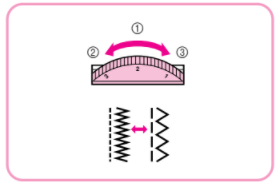
Reverse Sewing Button
To sew in reverse, push the Reverse Sewing Button in as far as possible and hold in that position while pressing lightly on the foot pedal. To sew forward, release the Reverse Sewing Button. The machine will then sew forward. Reverse sewing is used for backtacking and reinforcing seams.
- 1 Reverse sewing button

THREADING THE MACHINE
Winding the bobbin
- 1. Change the Clutch Release Switch from the needle mark to the bobbin mark.
- 2. Place a spool of thread onto the horizontal spool pin and firmly hold it with a spool holder so that the spool of thread will not turn. Pass the thread through the thread guide as shown following the dotted line on the machine.
- 3. Pass the end of the thread through the hole on the bobbin from the inside.
1 Clutch release switch
2 Bobbin winding

4. Place the bobbin onto the bobbin winder shaft and slide the bobbin winder shaft to the right. Turn the bobbin clockwise, by hand, until the spring on the shaft slides into the slit on the bobbin.
5. While holding the end of the thread, gently de press the foot controller to wind the thread around the bobbin a few times. Then stop the machine.
6. Trim the excess thread above the bobbin. Con tinue winding the thread onto the bobbin by de pressing the foot controller.
NOTE:
The machine stops automatically when the bobbin is full.
7. Cut the thread, push the shaft to the left and remove the full bobbin from the shaft.
8. Return the Clutch Release Switch back to the needle mark.
3 Spring
4 Slit

Lower Threading
1. Raise the needle to its highest position by turning the balance wheel toward you (counterclockwise) and raise the presser foot lever.
2. Open the shuttle cover behind the extension table on the front of the machine and remove the bobbin case by pulling its latch toward you and pulling it out from the shuttle race toward you (fig. A)
3. Unwind about 10 cm (4″) from a full bobbin and insert the bobbin into the bobbin case. Pull the trailing thread into the slot, down and to the left, as shown in fig. B below, until it enters the delivery eye under the tension spring.
4. Holding the bobbin case by the latch, fully insert the bobbin case into the shuttle race and release the latch. Make sure the metal finger fits into the notch at the top of the race as shown in fig. C below.
NOTE:
If the bobbin case is not properly placed back into the machine, it will fall out from the shuttle immediately after starting to sew.
1 Bobbin case latch
2 Bobbin case finger
3 Tension spring
4 Metal finger
5 Notch

Upper Threading
1. Raise the presser foot using the Presser Foot Lever as shown in fig. A below.
2. Raise the needle to its highest position by turning the balance wheel toward you (counterclockwise).
3. Place a spool of thread on the horizontal spool pin and press a spool holder onto the spool pin to hold the thread spool firmly in place.
NOTE:
Choose an appropriate spool holder according to the type and diameter of the spool being used. The diameter of the spool holder should be just larger than that of the spool itself as shown below in fig. B.
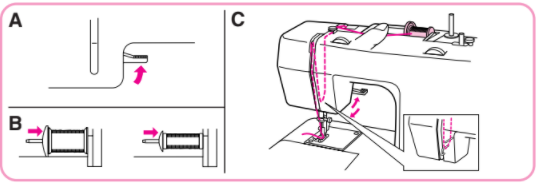
4. Pass the upper thread through the thread guides as shown in fig. C.
NOTE:
Make sure to guide the thread through the thread take-up lever from the right to the left. Thread the needle from front to back and pull out about 15 cm (6″) of thread.
1 Thread take-up lever
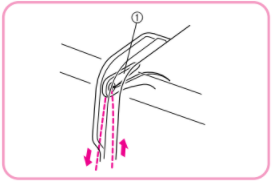
Drawing Up Lower Thread
1. Raise the presser foot and the needle to their highest positions.
2. With your left hand, hold the end of the upper thread. With your right hand, turn the balance wheel toward you (counterclockwise) until the needle moves down and back up again to its highest position.
3. The upper thread should have caught the lower thread in a loop. Pull the upper thread toward you and the lower thread will come up from the bobbin in a large loop.
4. Pull out about 15 cm (6″) of both threads and place them between the toes of the presser foot to the right toward the back of the machine and pull toward the back of the machine straight behind the presser foot.

1 Upper thread
2 Lower thread loop
3 Lower thread
Twin Needle Sewing
Your sewing machine is designed for twin needle sewing, which allows you to sew with two top threads. You can use the same color or two different colors of thread for making decorative stitches. Any of the patterns, except the buttonhole pattern, can be sewn with the twin needle. When using the Straight Stitch, the Stitch Width Dial should be set so that the needle is in the center position (between 2 and 3). However, when other patterns are used, set the Stitch Width Dial between 0 and 3. See page 11 for details on adjusting the Stitch Width Dial.
CAUTION:
When sewing with the twin needle, be sure the Stitch Width Dial is not set above 3 since this may cause the needle to hit the needle plate and break.
INSERTING THE TWIN NEEDLE
Insert in the same way a single needle is inserted (refer to page 6). The flat side of the needle should face toward the back and the rounded side should face toward you.
PLACING THE EXTRA SPOOL PIN
Place the vertical spool pin in the hole found on top of the machine near the horizontal spool pin. Place the second spool of thread onto the vertical spool pin as shown in fig. A.
TWIN NEEDLE THREADING
Each needle should be threaded separately.
1. Threading the Right Needle
Follow the same instructions for single needle threading using the thread from the spool on the extra spool pin. See page 16 for more details.
2. Threading the Left Needle
Thread the left needle in the same manner that the right needle was threaded, but do not pass the thread through the thread guide above the needle before passing it through the eye of the left needle as shown below in fig. B.
1 Right needle thread passes through this guide.
2 Left needle thread in front of this guide.

Thread Tension
Thread tension will affect the quality of your stitches. It may need to be adjusted when you change fabric or thread type.
NOTE
It is recommended that a test sample be made on a fabric scrap before sewing on your project.
Possible misadjustments and their results.
A Upper tension is too tight.
Locks appear on the surface of the fabric.
A-1 Upper Tension Control Dial
Decrease the tension by turning the dial to a lower number.
B Upper tension is too loose.
Locks appear on the reverse side of the fabric.
B-1 Upper Tension Control Dial
Increase the tension by turning the dial to a higher number.
1 Reverse
2 Surface

NOTE
Lower thread tension has already been adjusted for general use at the factory. For most sewing applications no adjustment is needed.
However, when sewing with thin thread on thin fabrics, the thread tension can not be adjusted enough with the Upper Tension Control Dial. There fore, the thread tension can be adjusted according to the procedure below.
I. Lower tension is too loose.
Locks appear on the surface of the fabric. Decrease the thread tension by turning the dial to a lower number. If the result is still not satisfactory then adjust the bobbin thread tension as shown below.
I-1 BOBBIN
Increase the tension in the bobbin by turning the screw with the enclosed small screwdriver in a clockwise direction, however, do not turn the screw more than one full turn.
Remember to return the screw to the original setting before starting your next project.
D Correct tension
Correct tension is important since too much or too little tension will weaken your seams or cause puckers on your fabric.
1 Reverse
2 Surface
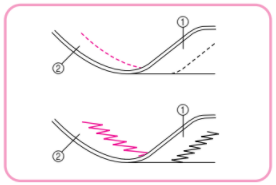
RELATIVE CHART OF SEWING FABRICS, NEEDLES AND THREADS
| SEWING FABRICS | THREAD SIZES | THREAD SIZES | |
| VERY THIN | Fine tricot, Fine lace, Thin linen, Silk, Organza, Chiffon | 9 | Cotton: 80 Synthetic Fine Mercerized Cotton |
| LIGHTWEIGHT | Voile, Taffeta, Synthetics, Silk, Batiste | 11 | Cotton: 60~80 silk: “A” Synthetic Mercerized 50 |
| MEDIUM WEIGHT | Cotton, Gingham, Poplin, Percale, Pique, Satin, Velvet, Lightweight wool, Fine corduroy, Suitings, Linen, Muslin | 14 (Supplied with your machine) | Cotton: 50~60 Silk: “A” Synthetic Mercerized 50~60 |
| HEAVYWEIGHT | Denim, Gabardine, Tweed, Corduroy, Canvas, Duck | 16 | Cotton: 40~50 Mercerized Heavy Duty |
| KNITS | Single Knit, Double Knit, Jersey, Tricot | Ball point 14 | Cotton Wrapped Polyester |
Straight Stitching
| Pattern | Stitch Length |
| 1 (Left needle position) | 1-4 |
| 2 (Center needle position) | 1-4 |
| 12 (Triple Stretch Stitch) | Fixed 2.5 |
Starting Sewing
1. Turn the Pattern Selection Dial to show your desired stitch on the Pattern Indication Window. Set the Pattern Selection Dial to 1, 2 or 12 for the type of Straight Stitch required.
2. Raise the needle to its highest position and lift the presser foot lever.
3. Pull up the lower thread by turning the balance wheel toward you (counterclockwise) and place the both the upper and lower threads toward the back of the presser foot.
4. Place the fabric under the presser foot and posi tion the needle 1 cm (3/8″) from the edge of the fabric.
5. Lower the presser foot.
6. To backtack, push the Reverse Sewing Button as far as possible and lightly touch the foot control ler. Reverse sewing is used for locking the end of seams and where reinforcement is needed.
7. Release the Reverse Sewing Button and start sewing in the forward direction by applying pressure to the foot controller.
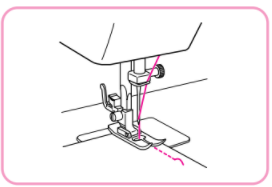
Changing Sewing Direction
1. Stop the machine at the point where you wish to change directions with the needle still in the fabric.
2. Raise the presser foot and turn the fabric to line up its new direction using the needle as a turning point.
3. Lower the presser foot and start sewing in the new direction.
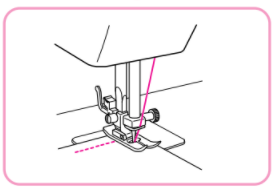
Finishing Sewing
Reverse stitching is used to lock the threads at the end of the seam or wherever reinforcement is needed.
1. Stitch to the end of the seam and stop.
2. Push the Reverse Sewing Button and lightly touch the foot controller to stitch backwards for 1 cm (3/8″) from the end of the fabric.

Removing the Material from the Machine
1. Stop the machine.
2. Raise the needle to its highest position and make sure that the thread take-up lever is also in its highest position.
3. Lift the presser foot and pull the fabric out gently to the left side.
4. Cut both threads using the thread cutter located on the back of the presser foot bar.
5. To prepare the machine for the next seam, pull about 10 cm (4″) of thread through the toes of the presser foot toward the back of the machine.
1 Thread cutter
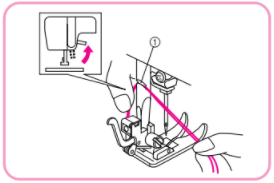
Top Stitching and Stretch Materials
No. 1 (Left needle position) is used for top stitching and sewing lightweight fabrics.
No.12 (Triple Stretch Stitch) is used for stretch fabrics.
Zigzag Stitching
| Pattern | Stitch Length |
| 3 (Stitch Width at 1.5 mm (1/16″)) | F-4 |
| 5 (Stitch Width at 3.5 mm (9/64″)) | F-4 |
| 5 (Stitch Width at 5 mm (13/64″)) | F-4 |
ZIGZAG STITCH
Select the pattern number according to the desired Zigzag Stitch width you require using the Pattern Selection Dial. Then select the stitch length. It is recommended to sew using the Straight Stitch at the beginning and end of the Zigzag Stitches.
SATIN STITCH
When the Zigzag Stitch length is set in the “F” range, it produces a Satin Stitch (a close Zigzag Stitch). The Satin Stitch can be used for making buttonholes and decorative stitches. Select the pattern number according to the desired stitch width. Then, set the stitch length in the “F” range.

Blind Hem Stitching
| Pattern | Stitch Length |
| 6 (Blind Hem Stitch) | F-2 |
| 7 (Stretch Blind Stitch) | F-1.5 |
The Blind Hem Stitch is used to finish the edge of a project like the bottom of a pair of pants without the stitch showing. Use the Blind Hem Stitch (6) for any non-stretching fabrics and the Stretch Blind Stitch (7) for stretch fabrics.
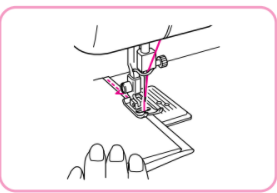
1. Both the threads should be the same color as the fabric.
2. Fold back the fabric to the desired location of the hem as shown in fig. A. Then, fold the edge of the fabric as in fig. B. Leave a 6 mm (1/4″) overlap at the edge.
3. Set the Pattern Selection Dial to either 6 or 7. 4. Sew on the fold as in fig. C.
5. When the fabric is unfolded you will have a Blind Stitch hem as shown in fig. D.
NOTE:
The Stretch Blind Stitch is useful for stretch fabrics.

Scallop Stitching
| Pattern | Stitch Length |
| 8 (Scallop Stitch) | F-1.5 |
This machine automatically produces a Scallop Stitch which may be used as a decorative edg ing.
1. Set the Pattern Selection Dial to 8.
2. Sew the Scallop Stitch along the edge of the material.
3. If desired, trim around the scallop with scissors to create a scalloped edge. Be careful not to cut the thread.

Overedge Stitching
| Pattern | Stitch Length |
| 9 (Elastic Overlock Stitch) | Fixed 2.5 |
The Elastic Overlock Stitch can join together seams and finish them in one operation. This stitch is useful when sewing stretch material.
1. Set the Pattern Selection Dial to 9.
2. Position the fabric under the presser foot so that the seamline is approximately 3 mm (1/8″) to the left of the center of the presser foot. This stitch works best with a seam allowance of approximately 6 mm (1/4″) as this allows the right (zigzag) side of the stitch pattern to overlock the cut edge of the fabric as shown in fig. A.
3. If the seam allowance is wider than the stitch pattern, trim away any excess fabric after stitching.
A finished Elastic Overlock Stitch is shown in fig. B.
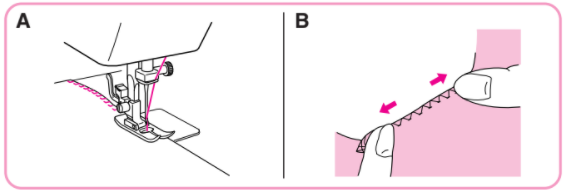
Elastic Stitching
| Pattern | Stitch Length |
| 10 (Elastic Stitch) | F-2.5 |
The Elastic Stitch can be used for 3 functions: mending, sewing elastic or joining fabric. Each is explained below.
Set the Pattern Selection Dial to 10.
MENDING
1. Set the Stitch Length Dial between F and 2.5.
2. Place the reinforcement fabric under the tear to be mended.
3. Following the line of the tear, sew using the Elastic Stitch as illustrated in fig. A.
SEWING ELASTIC
1. Place the elastic on the fabric.
2. As you sew, stretch the elastic both in the front and behind the presser foot as shown in fig. B.
JOINING FABRIC
The Elastic Stitch can be used to join two pieces of fabric together and is very effective when sewing knitted fabrics. When nylon thread is used, the stitch B
will not be visible.
1. Place the edge of the two pieces of fabric together and center them under the presser foot.
2. Sew them together using the Elastic Stitch taking care to keep the two fabric edges close together as shown in fig. C.
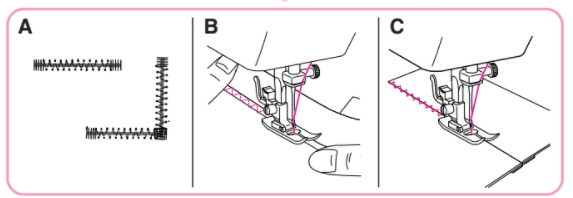
Triple Zigzag Stretch Stitching
| Pattern | Stitch Length |
| 11 (Triple Zigzag Stretch Stitch) | Fixed 2.5 |
This stitch can be used to sew heavyweight stretch fabrics wherever a Zigzag Stitch could be used. The Triple Zigzag Stretch Stitch can also be used as a decorative top stitch.
Set the Pattern Selection Dial to 11.
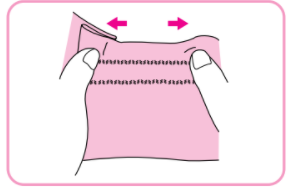
Making a Buttonhole
| Pattern | Stitch Length | Foot |
| a bc d | F-1.5 | Buttonhole foot |
NOTE:
1. It is recommended to practice making a button hole on a scrap piece of fabric before attempting it on the actual garment.
2. When making buttonholes on soft fabrics, place stabilizer material on the underside of the fabric.
Buttonhole-making is a simple process that pro vides reliable results.
MAKING A BUTTONHOLE
1. Using tailor’s chalk, mark the position and length of the buttonhole on the fabric.
2. Attach the buttonhole foot and push the silver frame back until it stops with the plastic insert in the front of the metal frame.
3. The front bar tack will be sewn first. Place the fabric under the presser foot so that the center of the front bar tack mark is directly under the center of the presser foot and aligned with the two red lines as shown below.
1 Front of chalk mark

MAKING A BUTTONHOLE
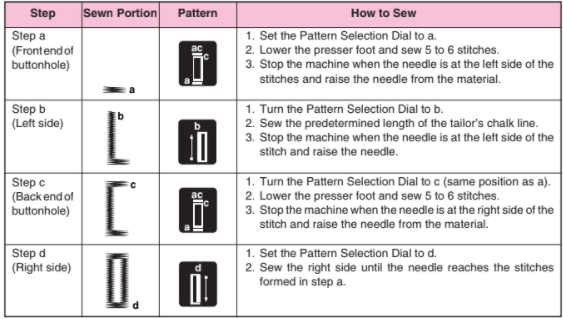
SECURING THE STITCHING AND CUTTING THE BUTTONHOLE
1. To secure the stitching, turn the material 90 degrees counterclockwise and sew Straight Stitches (2) to the end of the front bar tack of the buttonhole.
2. Remove the material from the machine. It is recommended that pins be placed across both ends of the buttonhole as protection against cut ting the stitches.
3. Cut an opening in the middle of the buttonhole with a seam ripper tool. Be careful not to cut through any stitches.
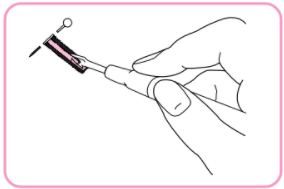
Buttonhole Fine Adjustment
If the stitching on the two sides of the buttonhole do not appear uniform, the following adjustments can be made.
1. Set the Stitch Length Dial at “F” and stitch the left side of the buttonhole on a scrap of fabric while observing how the material is fed.
2. If the left side of the buttonhole is too coarse or fine, adjust the feeding of the material with the Stitch Length Dial.
1 Left row
2 STITCH LENGTH
3 Shorter
4 Longer
5 In case
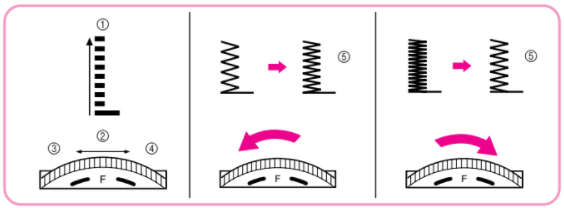
3. After obtaining a satisfactory feeding on the left side, stitch the right side of the buttonhole and observe the feeding.
4. If the right side is too coarse or fine compared to the left side, adjust the buttonhole fine adjustment screw as described below.
If the right side is too coarse, turn the screw with the enclosed large screwdriver in the – direction. If the right side is too fine, turn the screw with the enclosed large screwdriver in the + direction.
This adjustment allows both sides of the buttonhole to appear uniform.
6 Stitch length dial
7 Buttonhole fine adjusting screw
8 Right row
9 In case
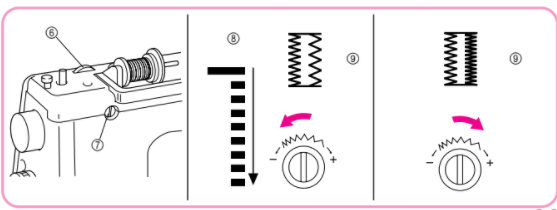
Button Sewing
| Pattern | Stitch Length | Foot | Other |
| 3,4 or 5 | Any | Button Sewing Foot | Darning Plate |
1. Measure the distance between the holes and select the appropriate pattern using the Pattern Selection Dial.
| Distance between holes | Pattern |
| 1.5 mm | 3 |
| 3.5 mm | 4 |
| 5 mm | 5 |
2. Change the foot to the button sewing foot. 3. Place the darning plate on the needle plate.
4. Place a button between the foot and the fabric and make sure that the needle enters the holes with out hitting the button. If it hits see step 1.
5. At a slow speed, sew approximately 10 stitches. 6. Remove the material from the machine. Cut the upper and lower threads and tie both threads at the back of the material.

Zipper Insertion
| Pattern | Stitch Length | Foot |
| 2 | 2-3 | Zipper Foot |
The zipper foot is used to sew various types of zippers and can easily be positioned to the right or left side of the needle.
When sewing the right side of the zipper, attach the shank to the left pin of the zipper foot. When sewing the left side of the zipper, attach the shank to the right pin of the zipper foot. See fig. A.
1. Set the Pattern Selection Dial to 2. Set the Stitch Length between 2 and 3.
2. Lower the presser foot lever and fix either the left or right pin of the zipper foot onto the shank. 3. Fold the edge of the material 2 cm (3/4″) and place the zipper under the folded portion.
4. Lower the needle into the notch located either on the left or right side of the zipper foot.
5. Sew from the bottom of the zipper toward the top on both sides. The needle should be positioned on the zipper side of the foot for best results. See fig. B.
6. To sew the opposite side of the zipper, release the foot by pressing the button located at the back of the presser foot, install the zipper foot on the other side of the zipper and continue sewing using the other side notch.
1 Zipper foot
2 Right pin for sewing the left side of the zipper
3 Left pin for sewing the right side of the zipper

Gathering
| Pattern | Stitch Length |
| 2 | 4 |
1. Set the Pattern Selection Dial to 2.
2. Loosen the tension of the upper thread (to about 2) so that the lower thread lies on the underside of the material.
3. Sew a single row or multiple rows of Straight Stitches.
4. Pull the lower thread(s) to gather the material.

Darning
| Pattern | Stitch Length | Other |
| 2 | Any | Darning Plate |
1. Place the darning plate on the needle plate as shown in fig. A.
2. Set the Pattern Selection Dial to 2.
3. Place the portion to be darned under the presser foot together with a fabric underlay for reinforce ment.
4. Lower the presser foot.
5. Begin sewing alternating between gently drawing the work away from you and pulling it toward you. With the darning plate on the machine the feed dogs will not move the fabric.
6. Repeat this motion until the portion to be darned is filled with parallel lines of stitching. See fig. B.

Appliques
| Pattern | Stitch Length |
| 3, 4 or 5 | F-2 |
An applique is created by cutting a contrasting piece of fabric into a shape to be used as a decoration on a garment or project.
1. Baste the cut design to the fabric in the location where desired.
2. Carefully sew around the edge of the cutout design with a Zigzag Stitch (patterns 3, 4 or 5) in the fine stitch length.
3. Cut away the surplus fabric outside of the stitch ing.
4. Remove the basting, if necessary.
NOTE:
Make reinforcing Straight Stitches at the beginning and the end of the stitching to secure.
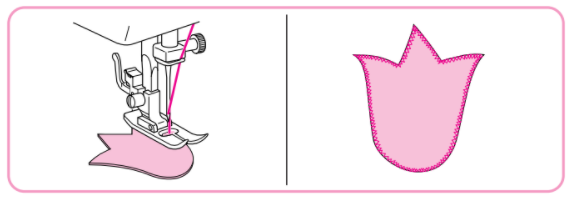
Monogramming and Embroidering
| Pattern | Stitch | Length Foot | Other |
| 3, 4 or 5 | Any | None | Darning plate |
PREPARING FOR MONOGRAMMING AND EMBROIDERING
1. Place the darning plate on the needle plate.
2. Set the Pattern Selection Dial to the appropriate Zigzag Stitch setting.
3. Draw the lettering (for monogramming) or design (for embroidering) on the surface of the fabric.
4. Stretch the fabric between embroidery hoops as firmly as possible with the underside of the fabric on the bottom of the inside hoop.
5. Place the work under the needle and lower the presser bar with the foot removed.
6. Pull the lower thread up through the work at the starting position by turning the balance wheel and make a few holding stitches.
7. Grip the hoop with the thumb and forefingers of both hands while pressing the fabric with the middle and third fingers and supporting the out side of the hoop with your smaller fingers.
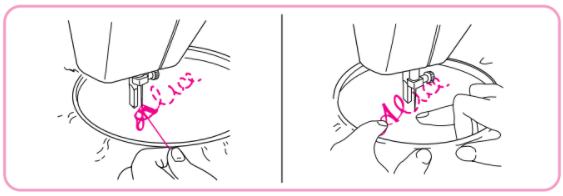
MONOGRAMMING
1. Sew moving the hoop slowly along the lettering at a constant speed.
2. Secure with a few straight stitches at the end of the last letter.
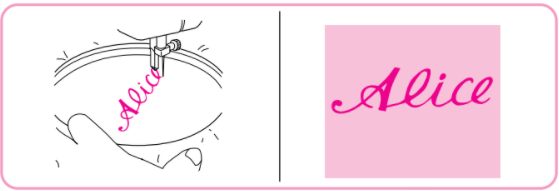
EMBROIDERING
1. Stitch the outline of the design by moving the embroidery hoop.
2. Fill in the design alternately from the outline of the design to the inside and from the inside to the edge of the outline until the design is completely filled in. Keep the stitching close together.
NOTE:
A long stitch is made by moving the embroidery hoop rapidly and a short stitch is made by moving it slowly. 3. Secure with a few straight stitches at the end of the design.
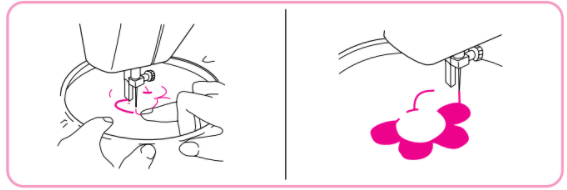
READ ALSO: Zewa Automatic Blood Pressure Monitor Instruction Manual (Model #: UAM-830 )
Changing the Bulb
1. Remove the power supply plug from the outlet.
2. Loosen the face plate screw as shown in fig. A.
3. Remove the face plate from the machine as illustrated in fig. B.

4. Replace the sewing light bulb. See fig. C.
5. Reattach the face plate and fasten the screw as shown in fig. D.
1 Bulb
2 Loosen
3 Tighten
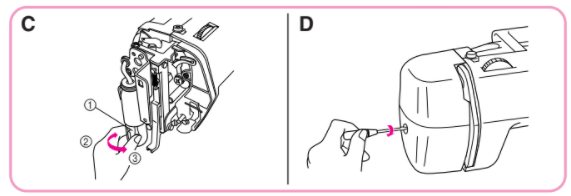
Oiling
1. Remove the power supply plug from the outlet.
2. Put 2 to 3 drops of oil at each of the points indicated in fig. A.
3. After oiling, run the machine at a fast speed without thread installed for a short time.
4. Be sure to wipe any excess oil off the machine.
NOTE:
The machine should be oiled once a week if it is used more than one hour a day. If the machine is used more often, oil every day.
Sewing machine oil is available from your local sewing machine dealer or service center.

Cleaning
Removing the Shuttle Hook
1. Raise the needle to its highest position.
2. Open the shuttle cover on the front of the free arm.
3. Take out the bobbin case by opening its latch and pulling it out from the shuttle race.
4. Slide the latch levers out from the retaining ring and remove the retaining ring. See fig. A.
5. Remove the hook by grasping the center post of the hook and pulling it out as shown in fig. B.
NOTE:
When the needle is lowered, the shuttle hook cannot be removed.
Cleaning the Shuttle Race
1. Remove any accumulated lint and thread from the retaining ring, hook, driver and race body with a brush.
2. A cloth dampened with machine oil should be used to wipe the shuttle race clean of lint.
3. Clean the shuttle hook in the same manner de scribed above.
4. Reassemble and push the latch levers back to their previous positions holding the retaining ring in place with the notch at the top.
1 Retaining ring
2 Latch lever
3 Hook
4 Driver
5 Race body
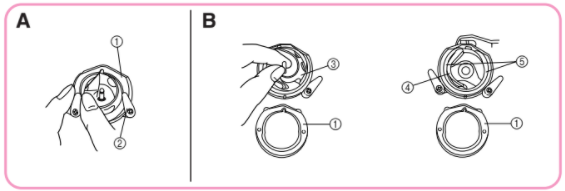
Cleaning the Feed Dogs
1. Remove the needle plate using a coin to unscrew the screws.
2. Clean the upper part of the feed dogs and shuttle race body with a brush.

Performance Checklist
Whenever sewing difficulties are encountered, re view the section in this instruction manual that details the operation you are performing to make sure you are correctly using the machine. If the problem continues, the following check list may help you to improve the operation.
If you still have difficulties, contact your nearest service center.
PERFORMANCE CHECK LIST
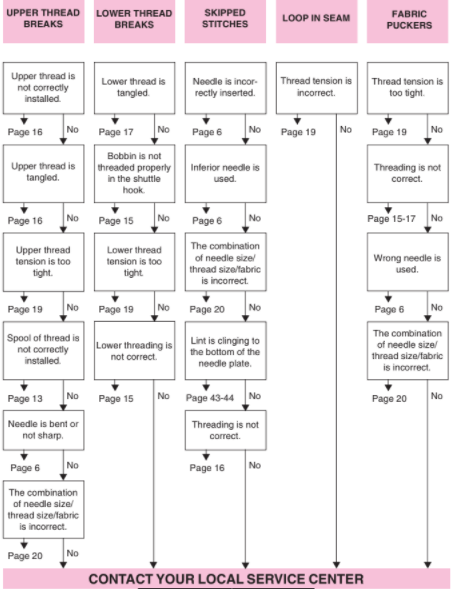
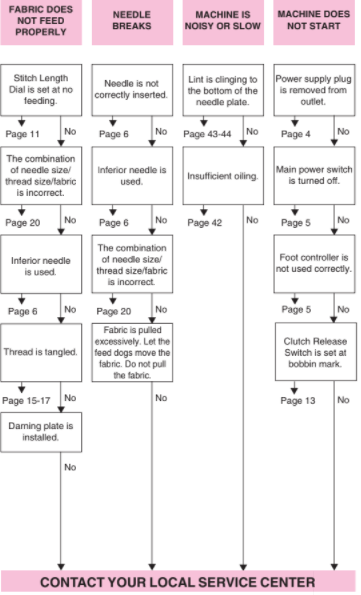
Repacking the machine
Keep the carton and packing materials for future use. It may become necessary to reship the sewing machine. Improper packing or improper packing material could result in damage during shipping. Instructions for repacking the machine are illustrated below.
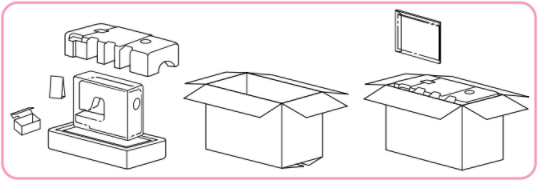
IMPORTANT
This packing material is designed to prevent damage in transit. Save this packing material in the event it is needed to transport this sewing machine.
Download PDF version of Brother XL OPERATION MANUAL here.
